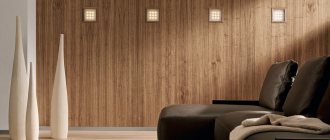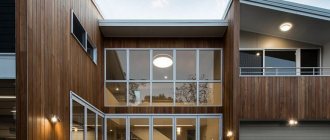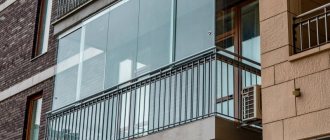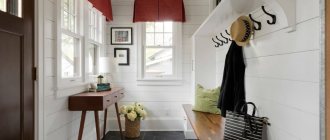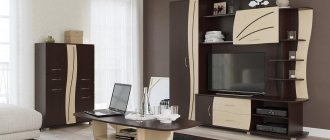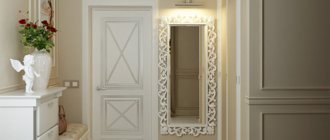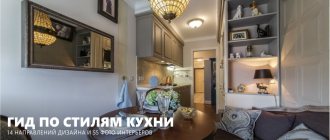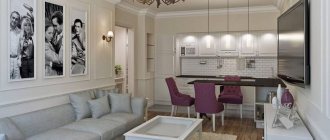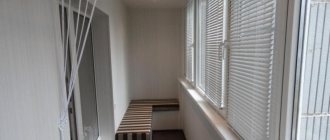Decorating the hallway with MDF panels, the advantages of the material
Before starting any renovation, you must immediately think through the general style of the room being renovated and select suitable materials.
Thanks to new technologies, the construction market offers a huge range of finishing materials. First you need to decide on the materials that are most suitable for the hallway. An excellent solution would be to decorate the hallway with panels. Decorating the hallway with panels, the advantages of the material
What materials are suitable for the hallway
The fact is that usually renovations in the corridor are carried out last, when all the other rooms have long been ready. Therefore, you should pay attention to the style in which the renovation was carried out throughout the apartment, and make sure that the hallway and other rooms are in harmony with each other. You can read more about materials in the article Ideas for decorating a corridor and arch.
Properties that materials must have:
- Wear resistance - the corridor of even the smallest apartment experiences maximum load (dust, dirt, friction, likelihood of mechanical damage).
- Non-marking finish - the hallway is the place where the street and the apartment are in direct contact: all dust and dirt remain in this room. Therefore, too light a finish is not appropriate.
- All surfaces in this room: walls, ceiling, floor should be as easy to clean or wash as possible.
Recently, finishing with MDF panels in the hallway has been gaining popularity, since this material is ideal for the room in terms of all technical characteristics. More information about the choice of material can be found in the article Decorating the hallway in the house, choosing a material.
Distinctive characteristics of MDF panels:
- Durability.
- Reliability.
- Fire resistance.
- Easy to install.
In addition, installation of the panels does not require preliminary preparation of the room. Typically, MDF panels are used to decorate public spaces: offices and shops. The fact is that the material is very easy to clean from dirt and dust. Therefore, finishing the hallway with MDF panels will be more than successful!
For your information! MDF panel is a medium-density fiberboard. Wall panels are even used in the decoration of ceilings and battery screens.
Advantages of MDF panels
Unique algorithm.
The under-panel space makes it possible not only to quickly and discreetly hide communications (electrical wires), but also to additionally sound and heat insulate the room.
The surface does not need to be prepared in advance; therefore, the contractor significantly saves time and money in the absence of leveling, cleaning old surfaces and puttying work.
Possibility of vertical and horizontal placement of MDF panels.
Huge selection of designer colors. Therefore, finishing the hallway with panels will turn a dull gray corner into a bright, exclusive corridor. But MDF panels also have their disadvantages: this material cannot be used in damp rooms. Since the base of the panel is still wood, and it has the unpleasant property of swelling.
MDF panels can be:
- Flat (either veneer or polymer film is applied on the front side).
- Embossed (an original design is cut out on the front part and covered with paint).
Based on size and shape, panels are divided into:
When the right choice has been made and the materials have been purchased, we begin finishing the walls in the hallway with MDF panels.
How to decorate a hallway with MDF panels, what needs to be provided?
The question of how to decorate a hallway with MDF panels was asked by every “home” master, because the installation must be carried out as professionally, efficiently and reliably as possible. I hasten to please you, there is nothing complicated about decorating walls with MDF panels! This instruction will help even a beginner understand all the intricacies of construction.
Step-by-step instructions for installing panels
We will need a list of tools and materials:
First you need to lath the walls using either wooden beams or, in order to save money, special profiles CD, UD. These metal profiles are designed for installation of drywall. CD and UD profiles are ideal for finishing walls with MDF panels and are much cheaper than wood.
In order to close the edges, joints and corners of the panels, you need to purchase in advance the required number of profiles of the type L (beginning and ending of work), F (special corner connection), H (used to close joints).
Advice. Depending on what type of panels will be installed, the frame will be constructed: vertical on a vertical frame; horizontal on a horizontally installed frame.
Frame construction
If vertical panels are to be installed, you need to use a regular thread with a weight to draw lines on the wall, maintaining a distance of 60 cm.
- Then you should install special brackets on the line and secure them with dowels or screws.
- Install a wooden strip or profile into the brackets, then secure with self-tapping screws. The slats or profiles are installed according to the level.
- You can find an interesting video on how to build a reliable frame on our website.
Decorating the hallway with panels^
- Next comes the next stage - finishing the hallway with MDF panels. To cover the walls in the hallway, a metal profile L is used. The corner, outer and inner profiles should be secured by rotating the wall.
- Then you need to measure the distance between the outer sides of the profile and subtract 5 mm. This way the performer gets the required length.
- Before installing the first MDF panel, you must first remove the starting chamfer. This action will ensure a tight fit of the panel to the profile.
- After installing the first panel, it is nailed with special staples using a construction stapler (if the frame is wooden) and metal screws (if the frame is metal).
- Subsequent MDF panels are installed according to this principle. You can see high-quality photos of similar works on our website.
Main types of panels
Depending on the criteria, you can select a huge number of varieties of MDF panels , thanks to which you can choose exactly the option that will not only suit you in terms of its practical properties, but will also be able to emphasize the style of the interior and decorate the hallway.
Depending on the specifics of production, all MDF panels can be divided into solid-pressed, laminated and moisture-resistant .
The main difference between solid-pressed panels is that they have an even and smooth base on both the outside and the inside. At the same time, they have average strength, are quite hygienic and environmentally friendly . We have already talked about the technology for creating solid-pressed panels: to create them, it is enough to compress wood pulp and process it at high temperature.
Laminated panels are produced in exactly the same way, but for additional protection they are covered with a special film that provides greater surface resistance to moisture, mechanical damage and other factors. Such panels are characterized by a wide variety of colors, and in addition, in appearance they resemble real wood.
By increasing the processing time at high temperatures, as well as using denser and higher-quality wood fibers, manufacturers were able to create unique moisture-resistant MDF panels. It is advisable to install such wall panels if you are worried that they will constantly come into contact with water (for example, during the washing process or after you have returned from a walk with animals in rainy weather).
It will be useful: How to make a cornice for furniture?
Since not only practical, but also aesthetic properties are important for finishing materials in the hallway, it is necessary to make a choice based on other classifications of such panels.
For example, depending on the size, all MDF panels can be divided into three categories:
Slatted panels are the most common: in appearance they resemble lining , the width of such panels can range from 148-300 mm, and the length - from 2400 to 3600 mm. Due to the variety of sizes, you can ensure ease and convenience of installation by choosing the best option.
Tile panels resemble regular tiles, but are larger in size . Their installation is carried out in the same way as for rack-and-pinion analogues. Sheet panels have the largest dimensions and are large sheets with an original pattern or relief texture. Quite often, MDF sheets with a height equal to the height of the walls are installed in the hallway.
Depending on the appearance, MDF panels can be divided into the following types:
- veneered;
- glossy;
- painted;
- embossed;
- volumetric, or 3-D panels.
Veneer panels imitate wood , and this effect is achieved by using wood veneer to create the outer layer of the structure. As a basis for such panels, you can choose ash, oak, mahogany and many other tree species.
The glossy surface of MDF panels is ensured by lamination with a special transparent film , due to which such materials not only look respectable, but also become more durable and reliable in use.
Painted panels are obtained through the use of special paint. This method of decorating MDF panels on the walls in the hallway is not often used, since the wood itself has a stylish appearance, but if you need to ensure a harmonious combination of the panels with the style of the room, you can choose this option.
Relief panels have an original appearance thanks to an unusual cut on the surface . These can be not only patterns, but also specific drawings that you can order from specialized companies.
with a 3-D effect in modern interiors is becoming a fashionable trend . Such panels have a special relief , processed with gold or silver paints, due to which the effect of antiquity can be achieved . In addition, panels of this type can imitate other natural materials: leather, marble and even silk , so your interior will always be original and stylish.
Link to article
Finishing with MDF panels is becoming today one of the simplest and fastest ways to turn the walls of a room into a beautiful and smooth surface. For the hallway, corridor, storage room and even the kitchen, this material will be a good solution. In fact, sometimes you don’t want to bother with “wet” repair processes or you need quick and effective repairs over a large area, then MDF panels easily solve these problems. Their design is becoming more diverse and allows you to create attractive interiors in a modern apartment, and the ease of installation is incomparable with other types of decoration. In this article we will give you some tips on covering hallway walls with MDF panels.
LET'S PREPARE THE TOOLS
To work with panels, you need to prepare a plumb line or laser level, a screwdriver, a fine-tooth hacksaw or jigsaw, a tape measure, a pencil and a metal square.
TWO INSTALLATION METHODS
There are two ways to mount MDF panels on walls: using glue or using a frame. Gluing allows you to save space in tight spaces, and the good thing about the frame method is that you can hide various utility lines in the cavities of the structure. You can also add that such panels can only be glued to smooth walls. And the frame method allows us to disguise any flaws on the wall that we do not want to perfect in the traditional way.
INSTALLING THE METAL FRAME
For the frame, you can use antiseptic wooden beams or galvanized profiles, which are used in plasterboard structures. But if for installation of drywall we install the supporting profile vertically, then for MDF panels the profile on the wall must be in a horizontal position. First you need to install a guide profile along the entire perimeter of the walls, near the floor and ceiling. We install horizontal profiles in increments of 500 mm, fixing them with U-shaped brackets to the wall. The quality of the entire work will depend on the geometric accuracy of the frame. When installing the frame, make sure that the lowest horizontal profile is pressed with its side to the floor. This will provide you with reliable fastening of the skirting boards in the future.
WE FIX THE PANELS WITH CLIPS
MDF panels can be attached to a metal profile using special clips, which, in turn, are attached to the frame with galvanized self-tapping screws with a flat press washer.
When buying a package with clamps, pay attention to the size - it is selected taking into account the thickness of the MDF panel, usually it is a clamp with a clearance of 2 mm. Pay attention to the package, the nails in the package are used on a wooden frame, and if you have a metal profile, then the screws are purchased separately.
We make fastenings in increments of approximately 500 mm. There is a groove and tenon on the sides of each MDF panel. We insert the protruding tenon tightly into the groove of the previous panel, and insert a metal clamp into the groove of the panel being fixed. Before attaching the clamp to the profile, press it tightly to the surface and check that the panel fits tightly into the groove so that there is no gap. The next panel will cover the clamp with a protruding ridge. This results in a hidden fastening.
With the use of clamps, we get a completely dismountable structure - the panels will again be ready for re-installation even if completely dismantled.
WE MOUNT PANELS WITH GLUE
Installing MDF panels on walls using glue is much faster, since there is no need to build a frame. But walls for adhesive installation must first be prepared. They must be fairly smooth and free of loose layers of paint and plaster. For better adhesion to the glue, the walls should be primed with an acrylate primer. As with wallpapering, you need to use a plumb line to determine the vertical line along which the first panel will be installed. And to prevent further misalignment, the first panel must be additionally secured with self-tapping screws in places where the traces will be covered by the plinth and decorative trim. In the future, you will still have to occasionally check the verticality of the installation. But first, let's figure out what kind of glue we need for the job.
Installation Features
None of the types of MDF panels will sufficiently perform their functions and provide the desired effect if you make mistakes during the installation process that affect its functionality. Therefore, it is extremely important to understand the features of installing such panels on the corridor wall.
First of all, you must prepare all the necessary tools . As we have already noted, it is not necessary to prepare the wall surface for such finishing; it is enough to get rid of the old wallpaper, so you can immediately begin installation. To do this, you will need a hacksaw, hammer, tape measure, cord, level, drill or hammer drill, screwdriver, special size screws, as well as wooden slats.
At the first stage, the frame is created . To do this, you can use wood, metal or special CS and UD profiles designed for such work. Panels of the required size will later be attached to the frame.
Don't forget to check how evenly the profiles are installed . To do this, you can use a level or a thread with a weight. At the next stage , staples are attached to them , which are secured with screws or dowels. A rail or profile is installed in the level brackets , secured with self-tapping screws.
When the frame is ready, you can begin attaching the panels . Ensure the installation of corner, external and internal profiles that will hold the panel. Measure the distance between the profiles, subtract 5 mm - and you will get the dimensions of the panel that needs to be installed.
The panel is attached to a wooden frame using a special stapler, and to a metal frame using screws . Once the first panel is installed, you can proceed to the rest.
In addition to the frame method, there is also the adhesive method, but it is less reliable . To do this, just glue the MDF panels to a flat wall surface and wait until they dry completely.
Read about how to replace the socket yourself - quickly and safely.
Find out here the cost of preparing walls for painting.
Installing MDF panels on the walls in the hallway is quite easy and simple, and such work will not take much of your time. Therefore, it is not at all necessary to call specialists for such installation.
Watch a short video tutorial: together with an assistant, in just half a day you can completely transform the interior of a corridor, like any other room, using MDF wall panels:
If you follow all the details of the installation process, you can ensure the creation of an ideal, beautiful and durable surface that will serve you for a long time and delight you with its appearance.
DIY wall panels for the corridor
The walls in the hallway, especially if there are small children or pets in the house, are subject to various damages and dirt much more than in other rooms. That is why finishing materials for the hallway and corridor must be chosen with special care, because this part of the house is the first thing that visiting guests see.
There are a lot of finishing materials that can be used in such cases, and each of them has its own advantages and disadvantages.
Materials required for mounting MDF
Special tools and additional elements will not interfere with the work
Any master, even a beginner, understands perfectly well: decorating a hallway with MDF panels is not the most difficult task. However, even here preparation is needed in order for the result to be of high quality.
In what order is everything done?
- First, you need to purchase the finishing material itself along with the necessary accessories and components;
- The number of panels required for the job is determined. It is important to consider here not the volume of space that needs to be closed - but its width - this is important.
In the case when individual panels on the wall will touch each other, you also need to buy specialized moldings. That is, you cannot do without additional expenses (you will also have to spend time).
- The right decision is to cover the wall with panels that are intact. The width of the MDF panel (we are talking about typical indicators) is 15 cm. However, there are panels whose width is both 19 and 24 cm;
- They do this: the width of the wall is divided by the width of the MDF panel that you are going to use. As a result, it will become clear how many panels you will need for finishing.
- When purchasing material, make a certain reserve: no one is immune from mistakes or defects. There will also be trimmings - this is quite normal.
Plastic panels
Panels made from polyvinyl chloride are an artificial material that does not contain cadmium or asbestos. Due to their cellular structure, they are ideal in situations where high-quality sound insulation is required.
Among the main advantages of plastic panels are the following:
- a huge selection of colors and patterns;
- the presence of a protective coating that provides good resistance to sunlight;
- Possibility of use in rooms with high humidity levels;
- ease of care;
However, given that the material is artificial, such panels are not recommended for use in finishing residential premises.
Advantages of MDF
The finely dispersed fraction (abbreviated MDF) has become popular for a reason. It has a large number of advantages that distinguish this material from others.
- First of all, finishing with panels is very easy and simple to do. It does not require special materials or tools. Basically, in every home you can find those devices that are needed when installing MDF.
- Easy to clean and wash. If the wall has been contaminated with anything, the stains can be easily removed by simple washing or damp cleaning.
- Versatility. The hallway can be made using panels not only on the walls. Slopes, doors and ceilings can also be treated with this material. And since the corridor is not a living space, MDF is especially suitable for it.
- The cheapness of the material always attracts many buyers. Compared to plastic, such a panel will be a little more expensive. But if you take wallpaper, paint, stone or wood for analysis, MDF panels will be much cheaper, stronger and more durable.
- Finishing with such material does not require additional hands - even one beginner is enough to complete everything flawlessly. And the involvement of specialists is not at all necessary.
- Environmental Safety. Many construction experts have argued many times that chipboard, plastic and even wallpaper can affect the health of residents. Unlike these materials, MDF is a tested material and we can say with certainty that it is environmentally friendly.
Considering all the positive features of these panels, you can definitely make a choice in its direction. Moreover, now in stores there is a fairly wide range of types of MDF. It can be made in any design - wood, floral print, plain, etc. The choice is up to the buyer. As for the disadvantages of the material, the only thing that can be attributed to them is that the panels are afraid of moisture and cannot be used in open rooms or on the street. They are rarely used in bathrooms and toilets.
MDF Corridor Wall Panels
In the manufacture of MDF panels, fine shavings and wood dust are used, which are compressed at high temperature and high pressure.
The panels, whose thickness reaches 16 millimeters, look like wood.
The advantages of MDF panels include:
- reliable and strong, yet easy to cut;
- increase heat and sound insulation;
- on sale you can find panels with moisture-repellent and fire-resistant impregnation;
- can be used to decorate any room, but they look best in the hallway and corridor.
Sheathing options
You can renovate a corridor using MDF panels in various ways, which allow you to get a completely individual interior.
Combination of elements
The standard design is to place the cladding vertically or horizontally. To do this, you can use light-colored parts, but it is recommended to decorate corners and openings in other shades. Also, the finish should not merge with the door leaf.
Classics are always relevant, in addition, continuous vertical or horizontal installation is the easiest to arrange
To diversify the interior, you can use a combination. In this case, the elements are installed in different directions on certain sections of the walls: the lower half of the surface is hemmed vertically, and the upper half horizontally. The joining points are decorated with special moldings. The diagonal arrangement of the panels will also look interesting.
The combined option opens up wide possibilities for creating an exclusive design with your own hands
It is taken into account that the division into zones may not have a clear geometry. The hallway looks beautiful, in which the products are divided into colors with a connection along a curved line. This method involves the use of a flexible profile.
Curvilinear joining of elements looks quite impressive, but such installation requires high professionalism from the master
If the room is large enough, then you can mount the fragments randomly: panels of a different shade are inserted at a certain distance. The main thing is to choose colors that will harmonize with each other.
Combination with other materials
The most difficult thing to transform is a narrow corridor. Possible options:
- The classic method: wallpaper is glued to half the wall on top and MDF on the bottom. The finishing is placed around the entire perimeter, taking into account that the lower part should be darker.
- An excellent option is to use photo wallpaper to place accents. Most often they are framed with panels. This is a rather complex technology, but if done correctly, it will produce a very interesting effect.
- You can also cover walls using wallpaper that imitates brickwork or stone. The products are placed in strips, and the rest of the space is lined with panels. This arrangement will create the visual effect of having niches. Wall decorative elements are used to enhance the impression.
- When renovating a hallway, decorative plaster is used as a complement to wood fiber products. It is placed similarly to wallpaper, creating the surface of the desired texture.
It is most difficult to arrange narrow halls; design experts recommend giving preference to light colors, especially in the upper sector of the room
On a note! You can decorate the room in an original way using beveled mirror inserts. The main surface is complemented by a complex pattern, which is obtained by frosting the glass.
Natural wood panels
In the manufacture of such panels, hardwood and wood with natural wood veneer are used. The main materials are: alder, cedar, oak, ash, pine, beech and maple.
After the panels are made, they are impregnated with special compounds to make the material resistant to moisture and fire.
- The veneer panel includes several layers. The main layer is made of pine, the cheapest material. Then a two or three-layer veneer is glued to it, on top of which the final one (made of valuable wood) is glued.
- The layers are bonded to each other through hot pressing.
- Finally, the panel is thoroughly polished and then covered with varnish, paint or wax.
The most expensive panels are made exclusively from valuable wood, with further polishing.
Features of installing plastic panels in the corridor
As soon as the optimal amount of finishing material has been purchased, you can begin its installation, which is very simple, but for this it is important to follow certain instructions and take into account some requirements. The process can be broken down into several different stages:
- Calculation of the required amount of material.
Initially, you need to take measurements of the room in order to decide exactly how many panels you need to buy in order to complete a competent and beautiful finish that will not be accompanied by any interruptions or other problems. Installation of plastic panels on the wall - Installation of sheathing. Plastic hallways require the use of a special sheathing during the installation process, which is usually formed using wooden slats. The result is a structure to which all the plastic panels can be attached very simply and quickly. However, it is important to remember that such a frame will slightly reduce the space in the room, and if it is very small, then the use of this method is not considered too acceptable. Instead of wooden slats, you can use special plastic elements. The distance between the individual elements of the sheathing must fully correspond to the width of the purchased panels, since in this case their installation will be simple, and minor joints between the elements can be ensured.
- Fixing the panels. Decorating the hallway with plastic panels must be done competently and correctly, and for this it is important to use only high-quality panels and suitable fasteners. This work begins from a certain corner of the room, and it is important, after attaching each panel, to fasten it with the subsequent element through grooves and tenons. If a joint is too large, it is important to adjust all the panels to each other using a rubber hammer. After creating a complete coating, it is important to treat all seams with silicone.
- Installation of skirting boards and corners. To avoid any visible joints or unnecessary transitions, special elements are used to decorate these places.
Fiberboard panels
The production of fiberboards is carried out by hot pressing of wood fibers, which allows the production of lignin (an organic binder). This completely eliminates the use of synthetic binders during production.
The advantages of fiberboard panels include:
- possibility of use in residential premises, since fiberboard panels are an environmentally friendly material;
- they are moisture resistant, so they can be washed as needed;
- Due to their appearance, such panels are excellent for decorating hallways and corridors.
Types of MDF panels
Today there are many types of MDF panels - some naturally imitate other materials
MDF panels vary in type - it all depends on how exactly the front part of the finishing material is finished. For example, the most popular are laminated panels - PVC film is applied to them during the production process.
Advantages of laminated MDF panels
- The film guarantees excellent aesthetic characteristics;
- It can naturally imitate a variety of textures (natural wood is no exception), just look at how finishing a hallway with MDF panels looks like - photo below.
Your hallway can get just such a finish thanks to MDF
- This material has dust-repellent properties;
- It is resistant to mechanical damage (and the level of resistance is high);
- Veneered panels are finished with high-quality wood veneer - any shade can be added to it at the customer’s request;
- If the panel is painted, then high-quality compositions were chosen for painting it, the stability of which is beyond doubt.
If you need to cut these panels, it is best to use a jigsaw. The cut will come out clear, completely smooth, without any burrs.
Variety of wall panels
Today, wall panels for corridors are available in various colors, textures and sizes. In accordance with this, all panels are divided into several more types.
Tile panels
Tile panels are similar in appearance to ceramic tiles, but on the reverse side they have a tongue-and-groove fastening system. Such panels can be used for finishing as the main material or in combination with other types of finishing, creating bright and unusual compositions. They are produced in various colors, often complemented by various finishes.
Slatted panels
In appearance, this material is very similar to the usual lining, but they are also equipped with a tongue-and-groove fastening system, which makes their installation much easier. In most cases, their height reaches from 2.5 to 6 meters, and their width reaches from 10 to 40 centimeters.
Sheet panels
Such panels are made in the form of monolithic homogeneous sheets, additionally decorated with various patterns. They are often used to decorate walls of non-standard sizes. The main distinguishing feature of sheet panels is the ability to install them on a flat wall without additional means.
Main types of panels
Depending on the criteria, you can select a huge number of varieties of MDF panels , thanks to which you can choose exactly the option that will not only suit you in terms of its practical properties, but will also be able to emphasize the style of the interior and decorate the hallway.
Depending on the specifics of production, all MDF panels can be divided into solid-pressed, laminated and moisture-resistant .
The main difference between solid-pressed panels is that they have an even and smooth base on both the outside and the inside. At the same time, they have average strength, are quite hygienic and environmentally friendly . We have already talked about the technology for creating solid-pressed panels: to create them, it is enough to compress wood pulp and process it at high temperature.
Laminated panels are produced in exactly the same way, but for additional protection they are covered with a special film that provides greater surface resistance to moisture, mechanical damage and other factors. Such panels are characterized by a wide variety of colors, and in addition, in appearance they resemble real wood.
By increasing the processing time at high temperatures, as well as using denser and higher-quality wood fibers, manufacturers were able to create unique moisture-resistant MDF panels. It is advisable to install such wall panels if you are worried that they will constantly come into contact with water (for example, during the washing process or after you have returned from a walk with animals in rainy weather).
Since not only practical, but also aesthetic properties are important for finishing materials in the hallway, it is necessary to make a choice based on other classifications of such panels.
For example, depending on the size, all MDF panels can be divided into three categories:
Slatted panels are the most common: in appearance they resemble lining , the width of such panels can range from 148-300 mm, and the length - from 2400 to 3600 mm. Due to the variety of sizes, you can ensure ease and convenience of installation by choosing the best option.
Tile panels resemble regular tiles, but are larger in size . Their installation is carried out in the same way as for rack-and-pinion analogues. Sheet panels have the largest dimensions and are large sheets with an original pattern or relief texture. Quite often, MDF sheets with a height equal to the height of the walls are installed in the hallway.
Depending on the appearance, MDF panels can be divided into the following types:
- veneered;
- glossy;
- painted;
- embossed;
- volumetric, or 3-D panels.
Veneer panels imitate wood , and this effect is achieved by using wood veneer to create the outer layer of the structure. As a basis for such panels, you can choose ash, oak, mahogany and many other tree species.
The glossy surface of MDF panels is ensured by lamination with a special transparent film , due to which such materials not only look respectable, but also become more durable and reliable in use.
Painted panels are obtained through the use of special paint. This method of decorating MDF panels on the walls in the hallway is not often used, since the wood itself has a stylish appearance, but if you need to ensure a harmonious combination of the panels with the style of the room, you can choose this option.
Relief panels have an original appearance thanks to an unusual cut on the surface . These can be not only patterns, but also specific drawings that you can order from specialized companies.
with a 3-D effect in modern interiors is becoming a fashionable trend . Such panels have a special relief , processed with gold or silver paints, due to which the effect of antiquity can be achieved . In addition, panels of this type can imitate other natural materials: leather, marble and even silk , so your interior will always be original and stylish.
Rules for choosing wall panels for a corridor
You should choose panels to decorate your corridor based not only on your ideas of beauty, but also on the characteristics of each material. If the front side of the selected panels is covered with wax, this means that the material has good resistance to moisture. However, in corridors, high humidity is not such a common occurrence, so this characteristic can be considered optional.
MDF panels are very durable, they can significantly increase the level of heat and sound insulation in a room. If they are required for finishing a room in which the air temperature will be high, it is worth immediately noting that in such conditions the material will quickly lose its attractive appearance.
Plastic
PVC corridor wall panels are excellent when the room requires additional sound insulation. They are simply a godsend if you need to implement a design solution, because their finish can be not only matte, but also glossy, cellular, with drawings and patterns. An important advantage is the ease of maintenance, because to clean the panels from dirt, you just need to wash them. Their main disadvantage is the unnaturalness of the material.
Tree
Wood comes first on the list of the most popular materials for wall decoration. The appearance of such panels can make the atmosphere in the house more comfortable, but the material is one of the most expensive.
Chipboard and fibreboard
The main positive feature of this material is its low cost. Perfect for those cases where a simple finish without frills is enough. The downside is considered to be low strength.
Cork
Cork panels are a natural, durable and lightweight material that significantly increases the heat and sound insulation properties of a room. Thanks to their cellular structure, they can become a real decoration of any corridor or hallway.
Advantages and disadvantages of MDF
The products are made from wood, which is highly processed. The resulting raw material acquires the desired shape under the influence of high pressure and temperature, after which decorative cladding is performed.
Advantages of panels:
- Density. The finishing material can withstand significant mechanical stress.
- Environmental friendliness. Although the composition contains binder resins, the products fully comply with safety standards.
Classic MDF panels do not have harmful inclusions at all, since the binder in them is lignin (natural glue), which is released from wood dust when the boards are “frying” under high pressure - Moisture resistance. All MDF wall panels tolerate changes in humidity well, and special options are impervious even to direct exposure to water over a long period of time.
- Decorative. The cladding is available in a variety of colors and textures.
The latest in fashion in MDF interior decoration are panels with 3D texture, but they are quite expensive - Additional sound and heat insulation. Although the parts are thin, they significantly reduce noise pollution and improve energy efficiency.
- Availability. This is a relatively inexpensive option.
The disadvantages include the possibility of deformation. This applies to the edges of parts that may get water from shoes or an umbrella. Another disadvantage is the abrasion of the coating from constant contact in the seating areas.
Decorating the corridor with wall panels with your own hands
Methods of fastening wall panels depend on the material they are made of and the quality of the walls:
- Due to their light weight, MDF and fiberboard panels can be mounted directly on the wall using glue (but only if the wall is perfectly flat). The glue is applied in a zigzag pattern to the entire surface of the panel, after which it is carefully pressed against the wall. The glue must be elastic and not interfere with the thermal expansion of the panel.
- As an additional method to mechanical fastening, you can use gluing the panel to the sheathing. This method is not suitable as the main one, since it is not very reliable.
- One of the most reliable methods of attaching a panel to a sheathing is using self-tapping screws. However, this method can only be used in rooms where there are no sudden temperature changes and high humidity. The reason is that self-tapping screws prevent the panels from expanding as temperature and humidity rise, which entails deformation of the material.
- Another, no less popular method is to fasten the panels to the sheathing using clamps. In this case, the panels are not at risk of deformation, so this installation method can be used for any room.
Before starting finishing work, it is necessary to accurately calculate the required amount of finishing material. In order for the store to help you decide on the right quantity, the sales consultant just needs to tell you the height and length of the walls.
Step-by-step instructions for attaching MDF panels to walls
If you have pre-treated the walls and stocked up on all the materials in the required quantity, taking into account the corners, moldings and other related parts, you can begin work on lining the hallway with MDF.
We form a frame from slats, fixing them on the wall with self-tapping screws, dowel nails or liquid nails. Using a building level, we make sure that the sheathing on the wall is level.
It will be useful: How to replace the threshold on a balcony door?
MDF sheets are attached to the slats with clamps (special staples) or small nails.
Important: work on installing the frame should begin from the most convex section of the wall, and then level the entire structure at the same level with this section.
The lathing along the hallway walls should be done horizontally with a pitch between slats of 400 mm. Failure to maintain equal intervals in the future, when installing panels, can lead to distortion of the pattern.
- MDF panels are attached to the sheathing in a vertical position.
- Installation of panels usually starts from the corner. In this case, it is better to completely cut off the mounting spike, which should be located in the corner, from the panel.
- Five or six gluers are installed in the groove of the panel at equal distances, which are then attached to the wooden battens of the sheathing using a screwdriver.
- The opposite end of the panel is fixed to the slats with self-tapping screws into pre-drilled holes 8-10 mm in diameter so that the head is “recessed” on the surface of the MDF.
- Each subsequent MDF plank is inserted with a tenon into the groove of the plank already fixed to the wall.
- All joints, side and top edges are fixed with corners using liquid nails.
- The lower joints are covered with a floor plinth, reinforced in any available way.
A hallway made of MDF panels, equipped with your own hands, is quite within the capabilities of any owner who is ready for creativity and experiments with various materials.
Combination of wallpaper and panels in the corridor
Corridors with high ceilings require special design attention. The large volume needs to be filled somehow and the solution would be to combine wallpaper and panels in the corridor. This is a popular type of finishing, and it can easily be done with your own hands, and there are plenty of options for combining materials.
Besides, you can always experiment and come up with something completely new:
- Horizontal combination in stripes;
- Vertical combination with stripes;
- Combination of wallpaper inserts into some areas of the panels;
- Combining shapes;
- A top-bottom combination, in which the panels can be located both at the top and at the bottom, although it makes more sense to define the panels down.
With the help of combined finishing, even very bold design ideas can be turned into reality. By using a variety of combination methods, you can create a truly unique hallway interior. Joints when separating areas of wallpaper and panels should be decorated with moldings, borders or friezes.
To give a city room the effect of a country house, you can use wood-look wallpaper. Read about it on the website: https://homeli.ru/remont-i-otdelka/steny/oboi/oboi-dlya-sten-pod-derevo
